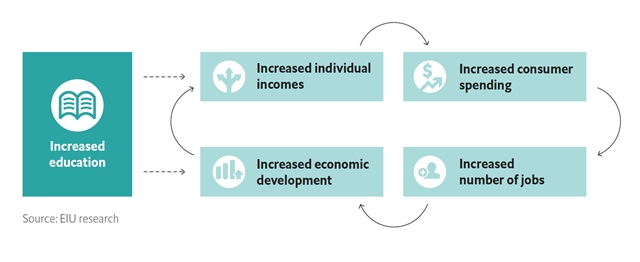 Society
Society


|
| A well-educated workforce is more likely to be innovative and foster ground-breaking ideas, leading to economic development and job creation. — Photo taken from the report |
HÀ NỘI — An Economist Intelligence Unit (EIU) report sponsored by Ericsson has found that nations with low broadband connectivity have the potential to realise an increase in GDP by up to 20 per cent by connecting schools to the internet.
Education systems worldwide have been hit hard by the pandemic, with more than 190 countries instituting nationwide school closures. During this time, connectivity at home has ensured continued learning for at least 100 million out of the 1.6 billion out-of-school students across the world. The temporary school closures are shifting perceptions on the need for connecting schools to support learning and to close both the educational and digital divides.
A well-educated workforce is more likely to be innovative and foster ground-breaking ideas, leading to economic development and job creation. Access to the internet in schools can also help provide equal opportunities to students in the form of improved learning. This in turn can open doors to new career pathways and a better quality of life, thereby benefitting the individual as well as society at large.
Both the World Economic Forum Global Competitiveness Index (2017), and the World Bank Human Capital Index (2017) show a clear correlation between access to internet and the quality of education available.
EIU analysis shows that for every 10 per cent increase in school connectivity in a country, GDP per capita can increase by up to 1.1 per cent.
While the global internet penetration rate has increased substantially from 17 per cent in 2005, it was still only at a modest 50 per cent this year.
In the West African country of Niger, the report finds that improvements in school connectivity to Finnish levels could increase GDP per capita by almost 20 per cent - from US$550 per person, to $660 per person by 2025.
The report focuses on four key actions including collaboration, accessibility and affordability, embedding the internet, and digital tools to educate and protect children online.
Ericsson has appealed for the world to get behind Giga (a school connectivity initiative founded by UNICEF and the International Telecommunication Union) with funding, data sharing, technological expertise and reimagining sustainable business models for connectivity. Ericsson has committed its efforts through a three-year partnership with UNICEF to help map the current school connectivity gap across 35 countries.
The Ericsson-backed EIU report – Connecting Learners: Narrowing the Educational Divide – has reinforced the company’s belief that the ambitious goal of Giga, to connect all schools and their surrounding communities by 2030, is achievable.
Heather Johnson, Vice President of Sustainability and Corporate Responsibility, at Ericsson, says: “When Giga was announced, we immediately understood the positive impact it could deliver - bridging the digital divide between and within countries and giving children the world over the opportunity to have bright and rewarding futures.”
“The report makes it clear that partnership between business leaders, public sector leaders and NGOs can be effective at addressing this issue and significantly impact lives. Every player in these sectors, no matter how big or small, can make a difference. We encourage stakeholders to read the report and more importantly join the Giga initiative to help realise this important goal, ” she added.
Charlotte Petri-Gornitzka, UNICEF Deputy Executive Director of Partnerships, says: “Together, we’re mapping schools around the world to identify connectivity gaps in communities. It’s key that we collaborate across sectors to connect schools and provide quality digital learning, children and young people can leapfrog into brighter futures.” — VNS




